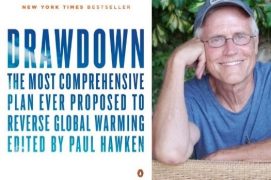In September I attended a Chattahoochee Riverkeeper Climate Change Conference where I heard Paul Hawken speak about his new book, Project Drawdown: The Most Comprehensive Plan Ever Proposed to Reverse Global Warming. His ideas had a huge impact on me. I left the presentation thinking very differently about how to talk about human-caused warming of the planet and how to tackle the issue. I left excited and more hopeful too, so I want to share some of what I heard.
According to Hawken, research shows that if we continue to scale up already existing practices, and implement close at hand solutions, we can reach the tipping point where greenhouse gasses (GHGs) peak and begin to decline, and do so before more catastrophic and irreversible changes occur. This is very good news; encouraging news.
From the Foreword of Drawdown: “We know we can’t avoid the cataclysmic impacts of global warming by only focusing on achieving zero net carbon emissions; we must also rapidly re-sequester carbon.” Drawdown concludes that, based on what the math shows, there are only two things we can do, only two goals worth pursuing that will make the definitive difference. One, stop putting GHG in the atmosphere. Two, bring atmospheric GHG concentrations down.

Paul Hawken with Drawdown Book Cover.
Hawken reminds us why we are doing this. Reducing GHG concentrations is the outcome we want, not the motive for acting. Our motive for acting is security and wellbeing for all on a livable, flourishing planet.
Project Drawdown is “the most comprehensive plan ever proposed” because it is remarkably the first, and only, comprehensive plan ever proposed to reverse global warming. Project Drawdown set out to identify the most impactful solutions that can re-sequester carbon and reverse planetary warming. To do that, experts were recruited to crunch the numbers for a range of possible solutions.
The research team eventually consisted of scholars from twenty-two countries on six continents, as well as a range of other experts. They “accumulated more than 5,000 references, citations, and sources in the process of researching and writing Drawdown.”
The result of all that number crunching? Maps, measures, and models of the 100 most viable solutions to global warming. Again, this is something that has never been done before. 80 of these solutions are “well entrenched with abundant scientific and financial information about their performance and cost.” These are solutions we know how to do very well, people around the world are doing them, and they are scaling up. They are explained in seven topical chapters:
· Energy
· Food
· Women and Girls
· Buildings and Cities
· Land Use
· Transport
· Materials
What is the number one cause of global warming? The research team was as surprised as anyone to learn that it is food: “If you add to livestock all other food-related emissions – from farming to deforestation to food waste – what we eat turns out to be the number one cause of global warming.”
Right there with food as a top cause of global warming is another surprise: the treatment and condition of 51 percent of the world’s population, women and girls. In three short subsections describing high leverage
solutions, Women Smallholders, Family Planning, and Educating Girls, Drawdown explains that by 2050 “enhancing the rights and wellbeing of women and girls could improve the future of life on this planet.” Fully implementing these initiatives will eliminate over 120 gigatons of GHG emissions! One gigaton = 1 million tons.
20 more solutions are categorized in an eighth chapter titled Coming Attractions that “provides a window into what is forthcoming and close at hand.” One coming attraction is building multi-story buildings with wood, a trend that is already emerging. “According to a 2014 study out of Yale University, building with wood could reduce annual global emissions of carbon dioxide by an impressive 14 to 31 percent.” Wood buildings are beautiful. People love working in them. And they are more fire resistant than concrete and steel. Just last month, the School of Forestry and Wildlife Sciences and a coalition of partners from on and off campus hosted an expert on wood buildings to talk about this emerging technology so we can consider the possibilities for Auburn’s campus.
Hawken noted there are 1400 more coming attractions in the Project Drawdown files, and they will be published soon.
Drawdown urges us to think and talk differently about global warming. We should think and talk less about fighting a war on global warming, and think and talk more about the opportunities this crisis creates as consequences of past and current behaviors become more apparent. It gives us reasons to “restore, redress, reform, rebuild, recover, reimagine, and reconsider” the way we do things. That’s why Hawken says that “Climate change is an offering, an opportunity.”
He went on to say that “Human creativity is leading us to a recarbonized future,” and that “We are now in a world of regenerative development.” “The way to reverse global warming is to create 1 billion restorative and regenerative jobs.” The top 100 solutions are “no regret” solutions. They have no downsides.
Drawdown’s message is practical, aspirational, and motivating. We have in our grasp proven technological, environmental, and social solutions to the greatest threat human civilization has ever faced. We cannot yet be sanguine about our prospects, but we are on our way.
After years of living with a gnawing fear that runaway global warming is inevitable, it is energizing to see the data-driven evidence that we can still achieve security and wellbeing for all on a livable, healthy planet. By applying at scale known solutions to global warming we can regenerate planetary systems and build a resilient, flourishing, and just society.





Mike,
It sounds like the Hawken presentation was genuinely energizing. Thanks for sharing the optimistic possibilities with your devoted readers. WDE
Bob